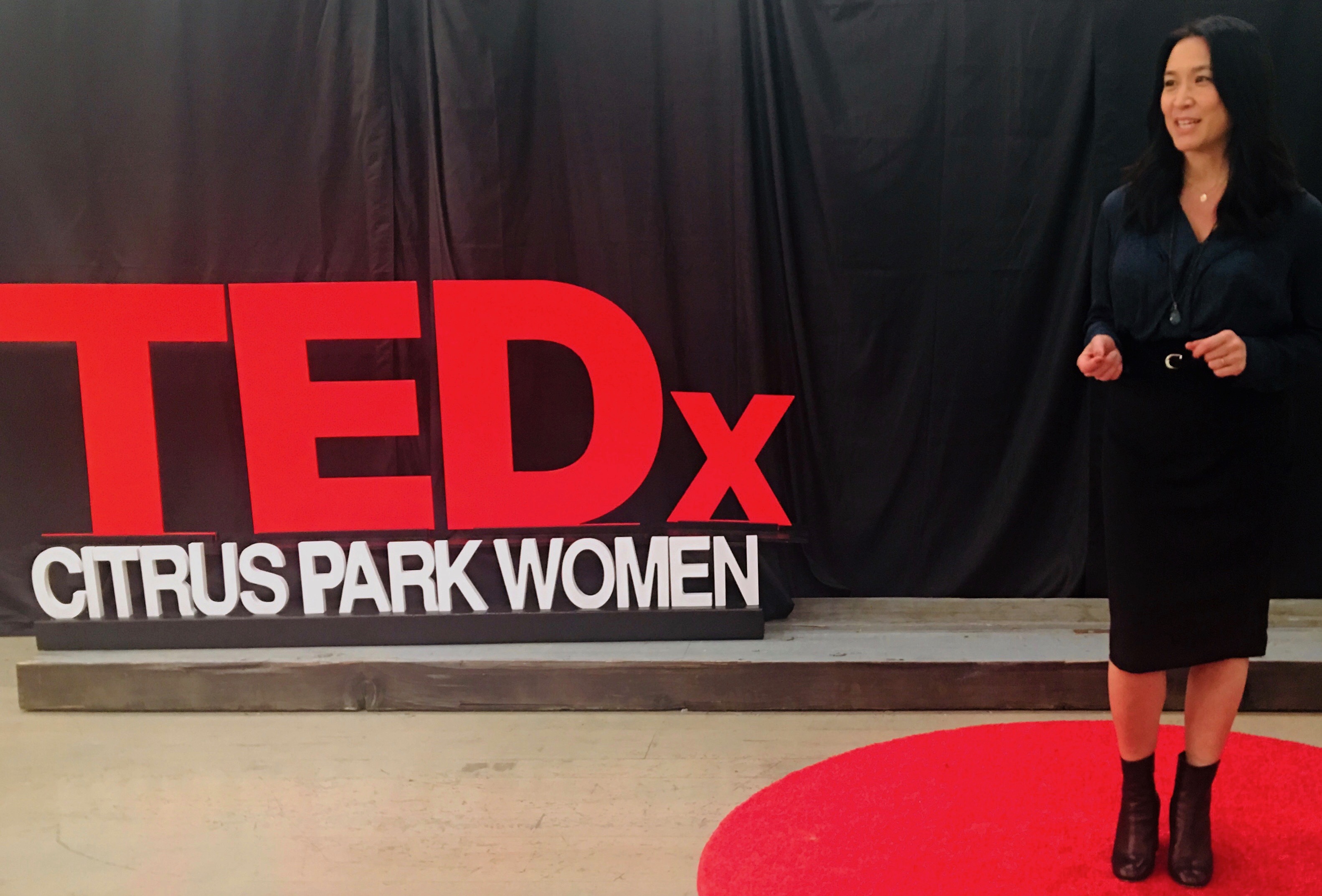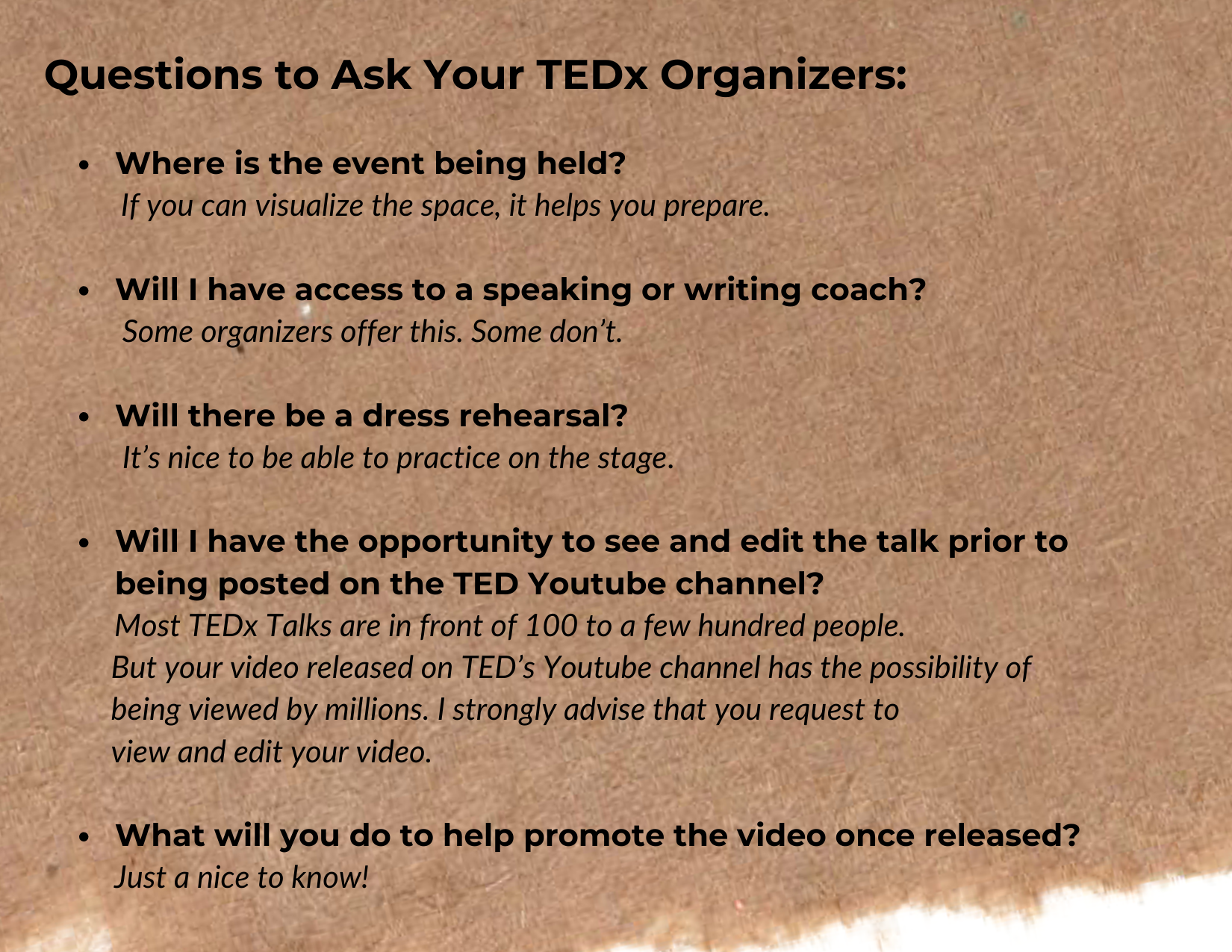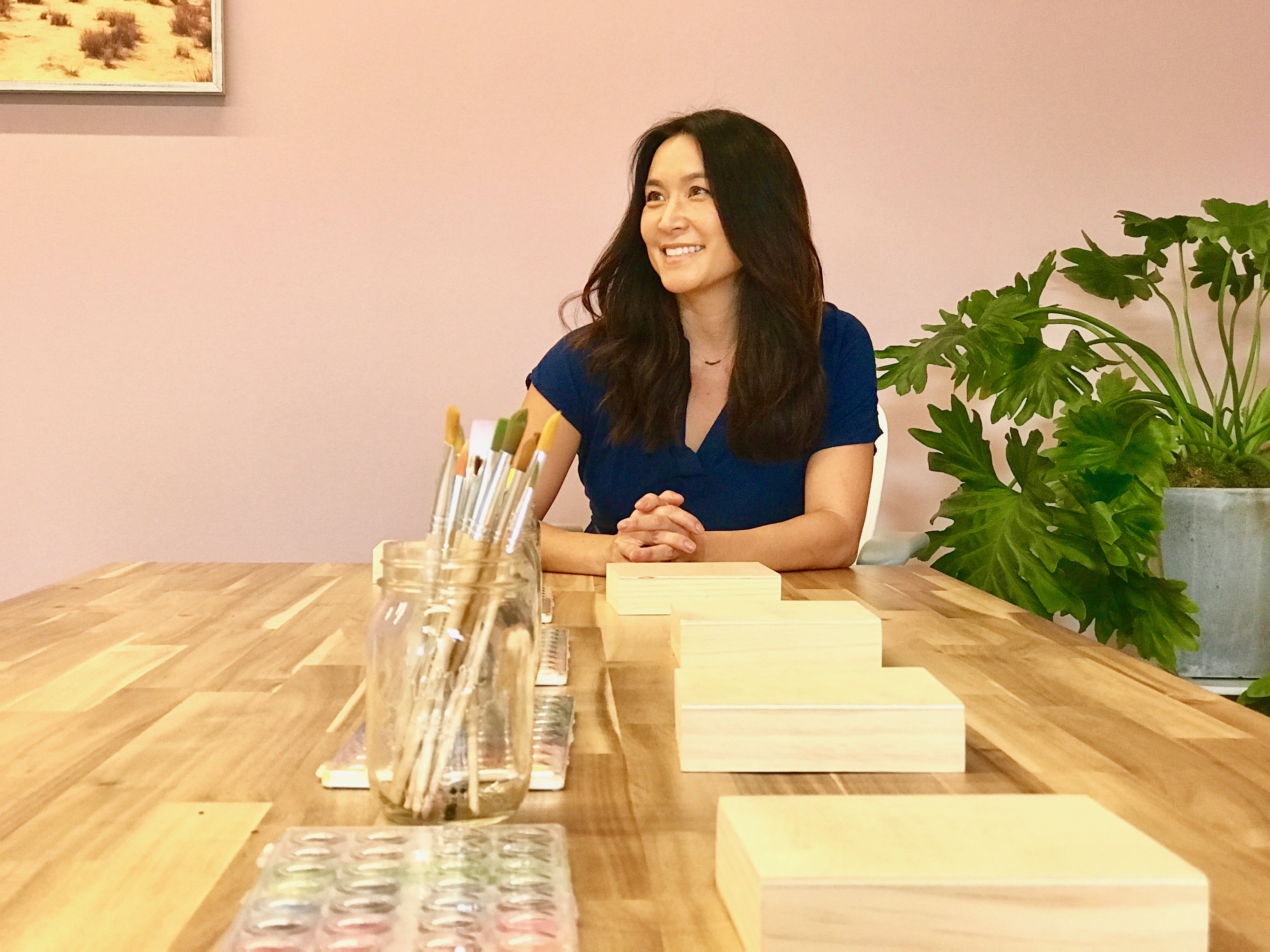My journey to a TEDx stage was not a typical one.
My journey to a TEDx stage was not a typical one. In fact, I stumbled on my TEDx opportunity by following the framework I share in my talk.
I followed my curiosity,
asked ‘What if?,
and took one small step forward.
I’ll tell my story a few sections down, but first let’s talk about what’s relevant to getting you on a TEDx stage.
Set Your Intention.
Since you are reading this, I’ll assume you have already set the intention that you want to present a TEDx Talk. Now, what are you going to do with that intention? You can keep it in your head, write it down in a journal and collage it on a vision board. Or, you can do what my friend Scott Asai did, and give yourself the title of ‘Future TEDx Speaker’ on your LinkedIn profile. Nine months later, Scott gave his first TEDx Talk – in Hawaii! I’m convinced that the bolder you are about projecting your intentions, the more likely you will get what you want (with this, and anything else).
Decide on Your Idea Worth Spreading.
Now with your intention set, you will need a well formed idea worth sharing. What you don’t need is your entire talk prepared before reaching out to TEDx organizers. Your idea worth spreading can be:
- A novel opinion on a subject matter
- A challenge to a known subject matter
- A framework you have developed
- A passionate message
- A new surprising idea
The key is to make your message powerful and relatable so others can become passionate about it, apply to their lives, and are moved to share it.
TEDx Talks are from you, but not about you. Even if your talk is based on a personal story, which mine is – your message needs to be relevant and applicable to a TEDx audience. Check that your message passes the ‘it’s about you, not me’ litmus test by asking questions like:
- What will people take away from my talk?
- How can my idea be applied to someone else’s life?
- Is my idea going to improve the status quo?
- What can I give the audience as a framework?
I formatted my message around both a framework that people can apply to their life, and a personal story I am passionate about telling. The framework I share is based on my work in creativity training. I teach individuals and teams to explore possibilities by following curiosity, asking ‘What if?’, and taking small steps towards their goals. And my passion for that message is rooted in a personal story about how following curiosity led to an unimaginable possibility for my family and thousands of other Vietnamese refugees and immigrants.
Once you have your message, create a 1-2 paragraph brief and keep it on a Google Doc along with a short 2-3 sentence bio. This way, you can easily cut, paste, and customize as you start your outreach.
Take Action to Find a Stage.
You might stumble across a TEDx Talk serendipitously like I did, but I recommend being proactive and search out events that are a fit for you.
The TED website has a page that lists all upcoming TEDx events.
Step 1. Find TEDx stages that works for you. Consider practical details like location. Organizers will most likely not pay for travel expenses, so know how far you are willing to travel. (Hint: When you are selected, be willing to ask if they are going to be covering any travel expenses. Never hurts to ask!)
Now that you have a list of upcoming TEDx stages you want to talk on, look at the theme of the event.
Step 2. All TEDx events have a theme. Does your talk fit into the theme? Or can it be adapted to fit into the event’s theme?
For example, I presented my talk at TEDx CitrusParkWomen. The theme was Mission of Mavericks. My talk is about the female mavericks who started the Vietnamese nail industry in the United States – it was an ideal fit. But my talk could have also fit into themes such as: curiosity, resilience, overcoming challenges, women empowerment, immigration, refugees, and entrepreneurship. I could go on. Bottom line is, with a little creativity, most talks can be adapted to fit several themes!
Step 3: Become a detective. Wouldn’t it be nice if the site above simply supplied you with the email of the person who books speakers for the event. Sometimes it is that easy. But get ready to put some elbow grease into this.
From the upcoming TEDx listings, you will be able to see events coming up several months out. Once you click on the event you are interested in, you might find links to:
- The TEDx Website for that event
- A Facebook Page for the TEDx Event
- An email for the organizers
- A request for speaker submission
What you WILL find is:
- The organizers’ names. From there, if you don’t have access to any of the above gold nuggets, you’ll have to do some research.
Tips to finding TEDx contact information:
- Google the name of the TEDx Event to see if they have a website
- Look up the organizer(s) on LinkedIn or Facebook
- Look up the TEDx Event on Facebook
THE PITCH
Pitch with confidence. Organizers are always open to hearing from speakers who will elevate their programming. Keep your pitch short, confident, and relevant.
Here’s where you refer back to your Google Doc, cut, paste and adapt your brief to fit the theme of each TEDx event. Below is an example of an outreach email. Adapt it to sound like it’s authentically coming from you:
Hello, I saw that you are organizing TEDx(location). Your theme of (theme) resonates with me because (I am passionate about … | I’ve created a framework around … | I have a story about …) I am interested in sharing my talk on your TEDx stage as I believe it is a message that will inspire and move your audience to action. A brief on my talk along with a short bio is attached. I look forward to the opportunity to connect with you on this. Thank you.
TEDx organizers get a lot of emails. Heck – I get a lot of emails, and you probably do too! Sometimes people need a gentle reminder that you’re interested, you’re serious, and you want this. So if you haven’t heard back from an organizer within 2 weeks of your initial pitch, send out a follow-up email that sounds something like this:
Hi, I am following up on an email I sent you a couple weeks ago with a submission to talk at your upcoming TEDx Event. I am eager to hear back from you as I have been thinking about how impactful it would be to to share (your message or idea) at your TEDx event. Are you currently accepting submissions? Thank you in advance for taking the time to reply.
MY STORY

For years I wanted to speak on a TEDx stage. But I only had a loose idea of what I would talk about; something around creativity at work.
Then, I got clear.
It was at an event hosted by the Vietnamese American Nail Association (VANA) – honoring the trailblazers of the Vietnamese American manicure industry. One of those trailblazers, my mom. As I sat in the audience I realized that this story is my TEDx Talk.
The idea worth spreading that came to me in that moment brought full circle my work in curiosity and creativity, and my personal story. My mom was one of the first 20 Vietnamese manicurists in the United States. An industry that is now worth 8.3 billion dollars. And it all started when Tippi Hedren, a Hollywood movie star, volunteering at a refugee camp, encouraged 20 Vietnamese refugee women to follow their curiosity about her long red manicured nails! Their story embodies my framework of following curiosity, asking ‘What if?’, then taking small steps to create great possibilities.
A week after I got crystal clear about my message, I was scrolling through LinkedIn and saw a post from Erica Morrison, an HR professional I had met at a conference two years earlier. The post read that she was organizing a TEDx Event and announced ticket sales. The theme: TEDxWomen: Mission of Mavericks. The theme jumped right off the computer screen!
I went directly to their website and saw the programming had been set, speakers had been selected, and they were moving on to selling tickets.
That could have been it. I could have stopped there.
But, instead of letting ‘reality’ stop me, I asked, ‘What if I pitch them anyway and asked if they have room for one more speaker?’
So I did.
I took that one small step and reached out via LinkedIn messaging, since I didn’t have her email address.
A few days later, I received a message back. ‘On behalf of the entire TEDxCitrusParkWomen Team, we would love to invite you to be a celebrated speaker at our event highlighting The Mission of Mavericks.’
Your yes might not come this quickly. But if you find your idea worth spreading, your yes will come! I’ve also heard that some TEDx organizers will require potential speakers send in a draft of their talk, participate in an interview, and even send in a video speaking from stage.
Ummm … now what?!
This is a feeling you will have to get used to if you start to follow your curiosity, ask what if and take small courageous steps forward. I was thrilled to hear yes, and now, I had to prepare for that yes by writing my script.
I call it a script, because as I will talk about in PART II of this article series – a talk is something you give. A script is something you memorize. And trust me – you are going to want to have this memorized!
For now, I will leave you with some questions you might want to consider asking your organizers after you get that yes!

You can watch my TEDx Talk here.


